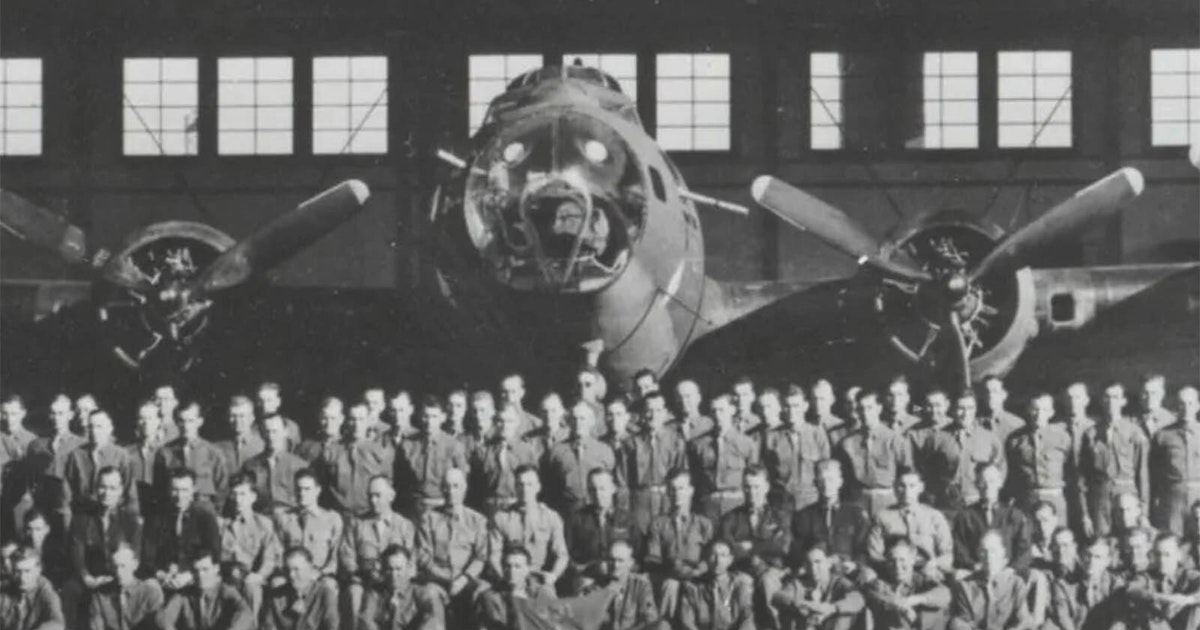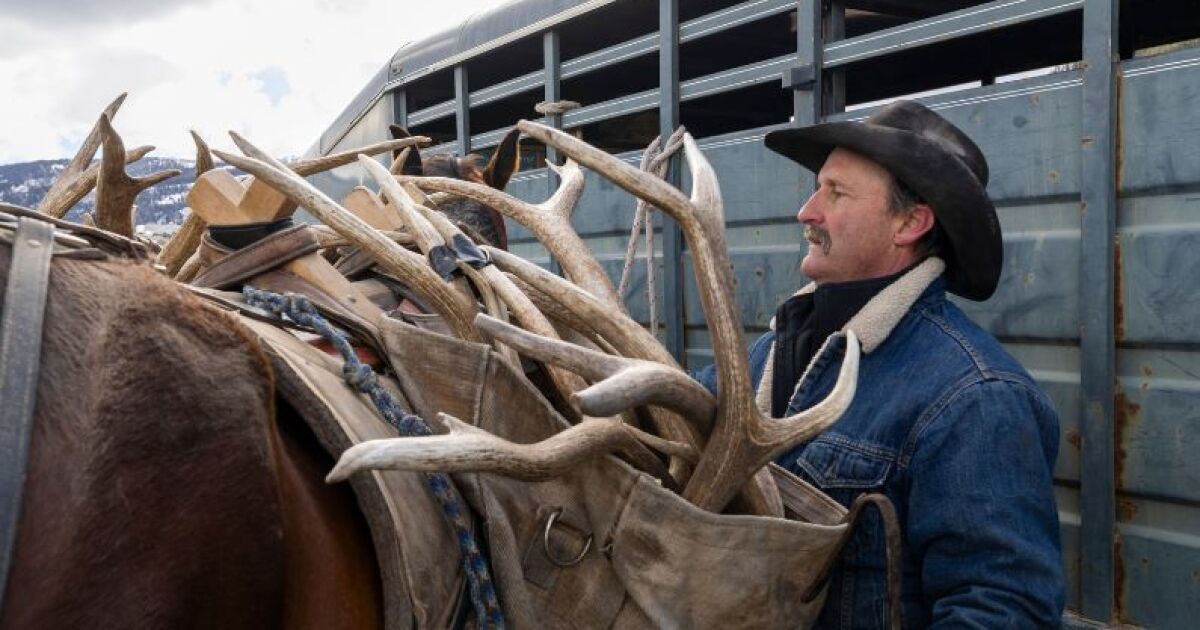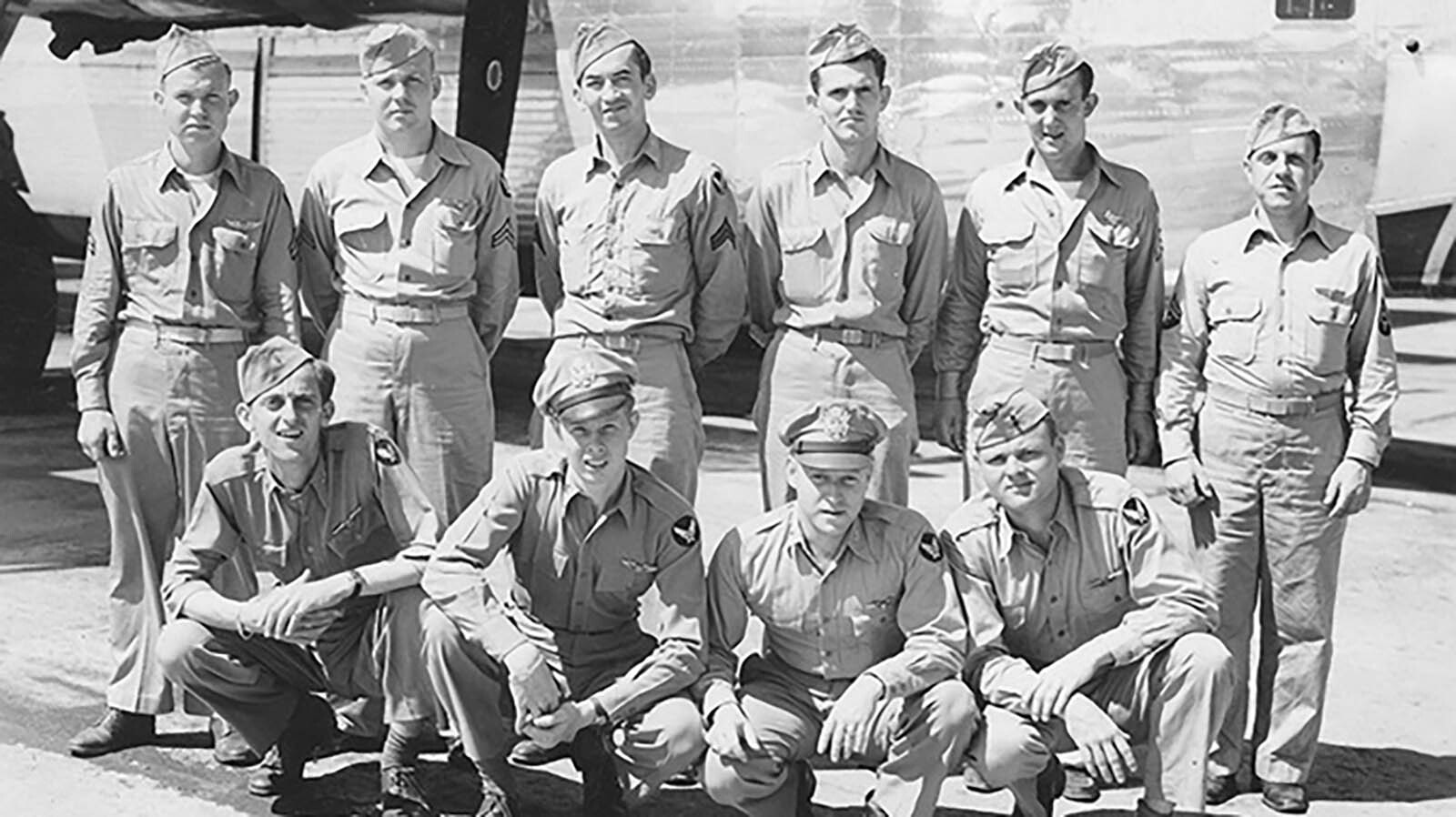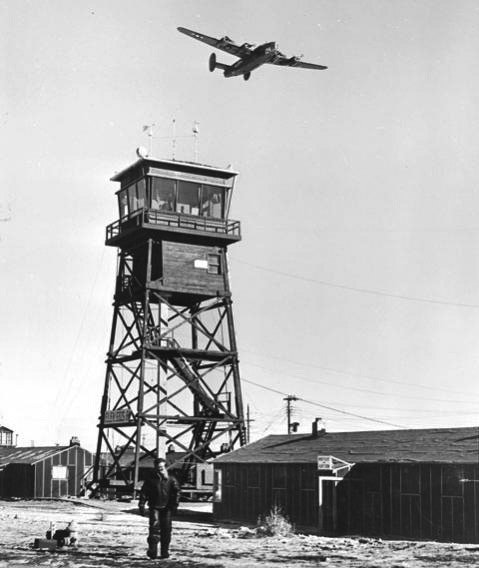Wyoming
Wyoming History: Casper Air Base Was Last Stop For WWII Bomber Crews Heading To War

The day Casper Army Air Base activated Sept. 1, 1942, the banner headline in the Casper Tribune-Herald read “Rommel Launches Offensive.”
The World War II German general nicknamed the “Desert Fox” had launched his North Africa campaign in an escalation of World War II.
But in Casper, the first of nearly 1,800 10-man bomber crews would soon be arriving to cycle through the base’s 10- to 12-week training. They were preparing to head for Europe, Africa and the Pacific in B-17s to challenge Rommel and other forces of German-Japan Axis.
Wyoming Veterans Memorial Museum Director John Woodward said the central Wyoming air base located where Casper/Natrona International Airport now sits was the last stop for World War II Army air crews headed overseas.
The base was built quickly that year to train the bomber crews for combat, and it became the training ground for a dominant part of America’s fight for freedom from the air. By the end of the war, an estimated 16,000 to 18,000 had trained there.
The Role
Plans developed by the Army Air Force called for the base to house an entire bombardment group that would typically house four squadrons of 18 heavy bombers in each squadron.
“Think of it as this is where the band got together,” Woodward said. “They had learned their instruments elsewhere, but this is where they were learning to work and fight as a team.”
Initially, the base operated as an operational training unit (OTU), and the 331st Bombardment Group trained pilots on B-17s and other members of the crew worked to keep their skills sharp. Crews would get assigned at the base and together would be sent overseas to fly as a team.
In early 1943, as the war progressed and air groups suffered heavy losses, the air base mission changed to being a replacement training unit (RTU). The base also transitioned to B-24 aircraft in April 1943. As an RTU, the needs overseas dictated whether the crews would stay together once deployed overseas or be assigned individually to existing crews that had lost men.
Bomber crews consisted of 10 that included the pilot, co-pilot, navigator, bombardier, flight engineer, radioman and gunners.
Creating the base was no easy task. As the summer of 1942 approached, the Army Corps of Engineers was given a budget of $10 million to get the base operational by Sept. 15, 1942. That figure in today’s dollars would be more than $191 million.
Infrastructure
In addition to runways and associated road infrastructure for the base, needs called for a railroad spur, warehouses, hangars, administration building, base chapel, barracks, dining hall and more.
With the need to build a base quickly, troops stationed there soon learned their barracks did not do well coping with the dust driven by Wyoming’s famous wind. The structures also didn’t optimally handle the snow and frigid temperatures of the winter.
“Soldiers regularly found thick layers of dust on their clothes, blankets and bunks,” a display at the museum relates. “Snow replaced dust during the rest of the year. … Some soldiers called the conditions ‘fighting the Battle of Casper.’”
Visitors to the Veteran’s Museum will learn that the base used specially trained civilian firefighters to deal with aircraft mishaps, and there were many. There were 90 crashes that occurred while the base was in operation.
“Those are major crashes that resulted in a fatality or near fatality,” Woodward said. “Smaller incidents that would have happened, like a crushed nose gear along the flight line or (an accident that) wasn’t significant, we do not have records of those. Just the ones that resulted in the loss of aircraft or the loss of life.”
Among the crashes was one in Mills and another on Casper Mountain.
In all, 140 men died in 90 crashes while training in Casper.
Female Mechanics
Members of the base fire department were not the only non-military personnel who worked on the base. A repair facility at the air base employed 800 civilians, mostly women, and they performed basic as well as more complex repairs to the aircraft, included replacing wings or tails.
As a training base, there also was a need for places where aircraft gunners and bombardiers could keep their skills sharp.
An air-to-ground gunnery range near the border of Fremont and Natrona counties gave crews about 55 square miles of space to send down painted ammunition that allowed trainers to help crews gain expertise.
The air base also had four bombing ranges that offered bombardiers big bullseyes for a target.
“Each practice bomb was a thin metal shell filled with sand and included a small explosive ‘flash’ charge in the nose,” according to a museum display. “Bombardiers relied on their specialized Norden Bombsights during training. These specialized, mechanical computers allowed crews to be very precise in dropping their bombs.”
Bob Hope Visit
Newspaper accounts show that after only a few months of operation, a special visitor arrived at the base. Comedian Bob Hope stepped out of a B-17 as part of a morale tour for troops stationed at the base.
An army air base newspaper called Slip Stream quoted Hope quipping about the B-17s: “It’s a Flying Fortress and that should be saying enough about that. They are as good as their reputation. I rode in every position on the plane and I like the ball turret best. It’s good for a hangover.”
As the war progressed, in March 1944, the 211th Army Air Force Base unit assumed command of the air base and training needs. The base’s last training class graduated Feb. 23, 1945.
Woodward said there are still an estimated 85 buildings from the time that remain standing in their original location. The museum building was once a club for enlisted men. All of the four hangars that once housed the heavy bombers still are in use at the airport.
“There are more (buildings from the base) that exist in Casper that were moved in the 1950s,” Woodward said. “And there are others that are scattered about central Wyoming that were sold to ranchers and farmers.”
Casper Army Air Base was officially deactivated March 7, 1945, just two months before Germany and its allies in Europe surrendered May 8, 1945. Personnel at the base were transferred to other military facilities. Victory over Japan would come Aug. 14, 1945.
“The county assumed operational control for the air base grounds in 1949,” Woodward said. “The base was officially deeded over in 1952, and before that was done the federal government did a sale and donation to different groups around Casper.”
Dale Killingbeck can be reached at dale@cowboystatedaily.com.

Wyoming
Australia Company Targets 85 Million Pounds Of Uranium In Northeast Wyoming

To meet growing demand for uranium worldwide, Australian-based Peninsula Energy Ltd. said that it has begun construction on a central processing plant in northeastern Wyoming.
The company’s Ross processing plant will take uranium processed at other Peninsula-owned mines in northeastern Wyoming and produce yellowcake, which is then shipped to Illinois to turn into enriched fuel for nuclear reactors.
The fuel supply chain looks upbeat for Peninsula.
On Monday, Peninsula expanded its estimate for uranium underground in its flagship Lance project near Gillette by 7.8% to 58 million pounds.
The company also expanded its estimates for uranium deposits by 19.6% to 26.2 million pounds in its nearby Ross and Kendrick mines, also located in the northeastern Wyoming area.
“This resource growth comes at an opportune time with the United States government continuing to take meaningful action to reinvigorate its domestic uranium production and nuclear fuel cycle capacity, [while] the company continues preparing for the resumption of commercial production at our U.S.-based Lance projects,” said Wayne Heili, Peninsula’s managing director and CEO, in a prepared statement.
Uranium Going Nuclear
Several uranium companies in Wyoming are posturing for increased production of the commodity because of higher demand in the United States for nuclear fuel, especially since federal lawmakers have responded to Russia’s invasion of Ukraine by banning imports from Russia.
This month’s ban by Washington has spurred domestic development of nuclear fuel for reactors and led to many uranium mining companies to restart production in Wyoming and elsewhere.
Uranium spot prices hit $107 per pound in early February but have since backed off to about $91 a pound as of Monday, according to Atlanta-based UxC LLC, which tracks uranium spot prices on a nuclear fuel exchange.
Peninsula does business in Wyoming through its Strata Energy Inc. unit, which operates the Lance project near Gillette and other mines.
The Ross central processing facility is a key part of Peninsula’s supply chain in Wyoming.
“This is a key piece of the jigsaw for us, providing the ability to produce a finished product for our customers without having to rely on any third-party processing facilities,” Heili said.
“We remain confident of hitting our production targets for 2025,” he said.
Samuel Engineering Inc., with offices in Wyoming and Denver, was hired by Peninsula to get the project ready for restart of production before the end of 2024.
Double Capacity At Ross
The Ross plant was originally built in 2015 as an alkaline in-situ recovery facility capable of producing up to 1 million pounds annually of uranium. Samuel was hired to build additional plant facilities to expand production capacity to 2 million pounds.
Instead of digging up uranium in a mine or surface pit, Wyoming’s mining companies perform in-situ recovery of the mineral. This kind of operation involves pumping oxygenated water with an occasional addition of bicarbonate of soda into the ground to get at the uranium.
In-situ mining has low environmental impact.
In this process, the uranium is dissolved and pumped to the surface, where the mineral is stripped from the water. The water stripped of uranium is then returned underground.
In March, Peninsula agreed to sell between $88 million and $117 million worth of Wyoming uranium to a European nuclear fuel buyer from the Lance project.
To pay for restart of production at the Lance facility, Peninsula raised nearly $60 million in late 2023. Combined, the company plans to take uranium mined at the Kendrick, Barber and Dagger project in Crook County, Wyoming, and convert it to yellowcake at the Ross processing facility.
The agreement with the European buyer requires the company to sell 1.2 million pounds of uranium over a six-year period starting in 2028 to Synatom, which manages the supply of enriched uranium to Belgium’s nuclear power plants.
With the inclusion of this new sales agreement, the company’s total contractual sales obligation over the upcoming decade is 6 million pounds.
Pat Maio can be reached at pat@cowboystatedaily.com.
Wyoming
Pokes Football: Best of Wyoming – No. 25

LARAMIE — It’s officially “series season.”
This summer, with the help of some longtime Wyoming football followers, we will count down the Top 25 homegrown products in program history.
As always, what these guys did in professional football doesn’t matter. This is all about production in Laramie. A couple of the guys on this final list may not have been born here, but they grew up in Wyoming and graduated from a in-state high school.
Once we put a bow on these selections, we’ll move on to other states like Colorado, Nebraska, Texas, etc. You get the picture.
So, let’s get this party started:
Cory Talich/ UW courtesy photo
No. 25 – Cory Talich
Linebacker, 1990-93, Pine Bluffs, Wyo.
Résumé in Laramie
Cory Talich was named second-team All-Western Athletic Conference during his sophomore season in Laramie back in 1991. That year the Pine Bluffs product finished with 64 tackles, including 11 for loss. He also forced two fumbles and picked off a pass. Talich racked up 167 tackles during his tenure in Laramie. All but five of those stops came during his final three seasons. He brought down the ball carrier 16 times behind the line of scrimmage and capped his career with two quarterback sacks and three interceptions. Talich’s brother Jim also played linebacker for the Cowboys from 1994-97. His son Nathaniel suited up for the UW basketball team in 2022-23.
About Pine Bluffs
Just a stone’s throw from the Nebraska border on Interstate-80, Pine Bluffs is home to roughly 1,100 residents. The town is located in Laramie County, just 42 miles east of Cheyenne.
(Cody Tucker and Jared Newland both work for Townsquare Media, which owns 7220sports.com. Kevin McKinney has been a color commentator of Cowboy football for five decades. Ryan Thorburn now works for the University of Wyoming in a sports information role after spending decades in the newspaper industry, most recently at the Casper Star-Tribune. Sally Ann Shurmur, the daughter of former UW football coach Fritz Shurmur, is also a veteran of the newspaper industry, working as a journalist, columnist at the CST for 43 years. She currently writes for Cowboy State Daily.)
University of Wyoming’s Top 50 Football Players
The rules are simple: What was the player’s impact while in Laramie? That means NFL stats, draft status or any other accolade earned outside of UW is irrelevant when it comes to this list.
This isn’t a one-man job. This task called for a panel of experts. Joining 7220’s Cody Tucker are Robert Gagliardi, Jared Newland, Ryan Thorburn, and Kevin McKinney.
We all compiled our own list of 50 and let computer averages do the work. Think BCS — only we hope this catalog is fairer.
Gallery Credit: 7220Sports.com
– University of Wyoming’s Top 50 Football Players
Wyoming
Shed hunt season opener draws hundreds of Wyoming residents

The sun had yet to rise, and over a hundred cars, trucks, and trailers sat idling in the county fairgrounds parking lot and down the neighboring street. Hunters were drinking coffee, reaching for their toes to limber up and some — saddling horses.
Then, 20 minutes before the 6 AM start of Wyoming’s annual shed hunt, flashing police lights led the motorcade out of town toward the elk refuge.
Brady Rivenes and his five shed-hunting passengers were 23rd in line. As he drove, his black truck’s headlights shined on herds of elk. The 24-year-old from Gillette says the rush — or the chaos, as he put it — is hard to explain.
“Especially since it’s over something stupid like elk horns,” Rivenes said.
This is his fifth year driving the six and a half hours from Gillette for the shed hunt, and he knew where he was heading.
He quickly hung a right leaving the motorcade, peeled down a gravel road, veered over the edge of it, and lurched into park beneath looming canyon walls just outside of the refuge boundaries.
The group leaped out of the truck, swung packs over their shoulders, and broke into a sprint alongside other hunters — like the start of an Easter egg hunt for grown men clad in camo.
“It’s exhausting — this is the definition of type two fun,” Rivenes said.

Dante Filpula Ankney
/
KHOL
Shed antler hunting season in the state opened on May 1, and the annual shed hunt in Jackson usually draws hundreds of vehicles from around the country. They come to search for antlers, which elk shed around this time every year.
But, this year, only Wyoming residents can participate for the first week — because of a new state law. The legislation was largely spurred by calls from Wyoming shed hunters who felt they’d been pushed out by swarms of out-of-state hunters in recent years as the sport has grown in popularity. While competition was still fierce, there were fewer people this year.
Wyoming Game & Fish’s Brad Hovinga said the legislation cut the number of registrations in the Jackson area in half, from around 300 to about 120.
“And quite honestly, it was about as low-key as an antler collection opener than we’ve seen in years,” Hovinga said.
That’s because, in years past, Game and Fish has found hunters trying to get an advantage by sneaking out early, which is illegal. But this year, Hovinga said, law enforcement didn’t cite anyone for jumping the gun. He added that they checked licenses sporadically and didn’t find anyone violating the new law.
The law has been largely celebrated among Wyoming shed hunters, but he said the department has heard from many non-residents who felt the law—making them wait—is unfair because the large majority of antlers, at least in Jackson, will already be collected.
“Non-residents that show may have to hunt quite a bit harder than they have experienced in the past when they were allowed to start on the first of May,” Hovinga said.
Jase Romrell from Star Valley was out on the opening day. He said he’s a fan of the law.
“It’s more special this year because we can actually benefit from being Wyoming residents,” Romrell said. “It makes me feel proud to come and pick up the antlers that you watch all winter and see on the refuge.”
Sitting atop his horse with multiple antlers slung to its side, he said this year is also special since his sons are joining him for the first time.

Dante Filpula Ankney
/
KHOL
“My goal was to get the twins, my two boys, an antler, and they both succeeded in that,” Romrell said. “I just wanted to put a smile on their faces and make them enjoy the outdoors as much as I do.”
He’s been shed hunting in Jackson for about 10 years.
“We enjoy looking at them. We enjoy using them in home decor,” Romrell said. “They’re special to us because it’s a Western living style.”
Brady Rivenes, the 24-year-old from Gillette, said he has mixed feelings about the new law.
“Yeah, I kind of go both ways,” he said. “It’s cool getting to see all the Wyoming guys get their first pick on horns but also kind of bittersweet because you don’t get to see all of your out-of-state buddies you’ve made from coming to this over the years.”
Back on the mountain, Rivenes ran up a rocky cliff to a ridge line that plateaus. The chaos he had prepped for earlier had come to fruition. He occasionally tripped on the uneven game trails as he scanned the hillside for antler points. The sunrise cast a pink glow above the Tetons and glistened off the thin snow crust.
“They’re hard to see in snow,” Rivenes said as he tried to catch his breath.
Moving fast, with no plans of stopping, he knew other hunters were right behind him. He was looking for pockets or clusters of many antlers he had had luck finding in previous years.
“Some years you find it, some years you don’t,” Rivenes said, “but either way, we’re not stopping.
Then, his pace quickened, and he yelled as he spotted one — then two. He scrambled to their side, threw off his pack, strapped them in, and, with no time to celebrate, kept moving.
He was unsatisfied.
“Not good enough,” he said. “From where we went through and to only have two — it’s surprising.”
By the end of the day, he’ll have added two more. His friends, who had all spread out, found another four.
Ultimately, it was “not too shabby,” Rivenes said.

Dante Filpula Ankney
/
KHOL
He’s had better years, but ultimately, it’s not just the thrill, the sheds, or the scenery that keeps him coming back.
“A lot of it’s the people,” he said. “We like to shed hunt, there’s sheds on this hill, everyone else gets to come together that likes to shed hunt and you get to see all those guys pick up horns, it’s just a good time in general.”
Rivenes returned to his truck and threw down his sheds, considered their size alongside the others, and debriefed the day cordially with other returning hunters. The competition was over.
He drove the gravel road out until he met the paved streets in town, grabbed a quick lunch at a local restaurant, and then hit the road back towards Gillette — all before noon.
Copyright 2024 KHOL.
That story was shared with KSUT via Rocky Mountain Community Radio, a network of public media stations in Colorado, Wyoming, Utah, and New Mexico, including KSUT
-

 Education1 week ago
Education1 week agoHow Counterprotesters at U.C.L.A. Provoked Violence, Unchecked for Hours
-

 Politics1 week ago
Politics1 week agoAustralian lawmakers send letter urging Biden to drop case against Julian Assange on World Press Freedom Day
-

 World1 week ago
World1 week agoBrussels, my love? Champage cracked open to celebrate the Big Bang
-
News1 week ago
A group of Republicans has united to defend the legitimacy of US elections and those who run them
-

 Politics1 week ago
Politics1 week agoHouse Dems seeking re-election seemingly reverse course, call on Biden to 'bring order to the southern border'
-

 World1 week ago
World1 week ago‘It’s going to be worse’: Brazil braces for more pain amid record flooding
-

 Politics1 week ago
Politics1 week ago'Stop the invasion': Migrant flights in battleground state ignite bipartisan backlash from lawmakers
-

 World1 week ago
World1 week agoGerman socialist candidate attacked before EU elections

















